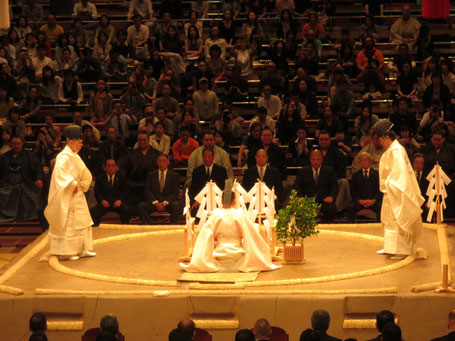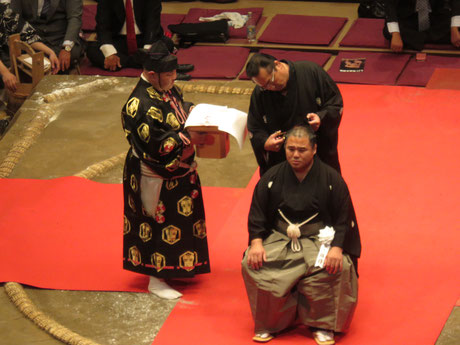How to see the Grand Sumo Tournament
Watch the tournament with a private guide!
I cannot book tickets on your behalf but I can join you for guidance on the background of the sport and sharing some information about each wrestler that appears.
Please visit my Viator page for information on booking a private guide to accompany your visit. The next offer will be for the September 2025 tournament (Sep 14-28).

If your visit to Tokyo is during the period the Grand Sumo Tournament is held (mid January, mid May and mid September) then you should certainly not miss the opportunity to see this in person.
All seats are reserved; there used to be a non-reserved seat (The last row 14 of the arena) but this has been discontinued and they are now being sold as "Reserved D" seats.
Tickets can be purchased in English from the official ticketing site, but the first and final day usually sells out almost instantly. The availability for the other days won't last much longer, so mark down the date when the tickets go on sale.
Official ticket site "Ticket Oosumo"
When: Normally the tournament starts on the second Sunday and goes on for 15 consecutive days, thus ending again on a Sunday.
2025 schedule:
January tournament (TOKYO) Jan 12-26, tickets on sale Dec 7...tickets sold out on the first day
March tournament (OSAKA) Mar 9-23, tickets on sale Feb 8
May tournament (TOKYO) May 11-25, tickets on sale Apr 5...tickets sold out within few hours
July tournament (NAGOYA @ IG Arena) Jul 13-27, tickets on sale May 17
September tournament (TOKYO) Sep 14-28, tickets on sale Aug 9
November tournament (FUKUOKA) Nov 9-23, tickets on sale Sep 20
What time: The wrestlers in the lower categories start before 9 am, however the top-ranked wrestlers only appear around 4 pm. This is when the majority of the crowd shows up, though you're free to arrive at any time of the day. You are permitted re-entry just once, and you must arrive back by 5pm. The final match featuring the Yokozuna (highest-ranked wrestler) finishes shortly before 6 pm.
During the final 15th day of the tournament, the final match is over around 5:30 pm, with the awards ceremony following that.
Access to the arena:
It is a short walk from the west exit of JR Ryogoku Station. Outside the station, there is a Seven-Eleven (if you need to retrieve tickets) and several restaurants that serve the sumo chanko cuisine. The station can get extremely crowded after the tournament finishes, though if you wait just 15-20 minutes, the congestion eases.
The Toei Oedo subway line also has a Ryogoku Station which is about 7-8 minutes east of the arena. For the shortest route, head in the direction of the APA Hotel, staying to the north of the JR tracks.
Tutorial on a day at the Kokugikan
Here is a video I made...it's a bit long but gives you the rough timetable of a day at the tournament. Note the empty seats are because these were taken in late 2020 when there was a limit on the number of spectators allowed.
The view is from the front side ("Shomen"), the same angle as the TV broadcasts.
How is the view from my seat?
The Kokugikan arena has a capacity of around 11,000 with a lower deck and upper deck. There is a clear view from every seat; no pillars that would obstruct the view.
Seats in the lower bowl are the traditional Japanese type where one takes off their shoes and sit on a cushion. There are box seats accommodating 4-6 people. The front row Tamari seats are rarely sold to the public, usually secured well in advance by long-time sponsors.
The upper deck features the normal arena type seats though legroom is a bit tight. Still, these seats will be far more comfortable than the traditional ones. (Imagine sitting on the floor with no back support for a few hours - it's quite tough, even for a Japanese!)
For both the lower and upper deck, category A is closer to the ring, category C further away.



Shomen 正面 is the same angle that you will see on TV broadcasts. Since there is no price difference between the other three sides, these seats tend to sell faster. All of the ceremonial events will be done with the wrestlers facing this way.

Muko-jomen 向正面 refers to the reverse side of the ring. One advantage is that you will have a better view of the Hanamichi, the passageway where the wrestlers appear and exit.
東Higashi/East and 西Nishi/West refers to the seats with a side view of the ring, at least at the beginning of the match. Don't be too disappointed if you get these seats because once the match begins, there's no telling which direction the wrestlers will be going. You might end up having the best angle of what happened at the conclusion of the match.
The Kokugikan is configured specifically for sumo, with the arena in an even square shape so there is a clear view from any angle. On the other hand, the arena in Osaka is in a rectangular design more suitable for basketball or volleyball so seats near the corner of the arena will have a very distant view of the ring.
Will tickets sell out?
Yes, and often times within the first few minutes of the sale. In the past, tickets for weekdays would be remaining for a few days after the sales started. However since the May 2024 tournament, the ticketing site often crashes on the first day and by the time it is running again, all days are showing as "sold out".
Many tickets eventually make its way to unofficial reselling platforms so there seems to be a fair number of people who buy with no intention of actually going. It is also possible tour companies are buying in larger quantities to cater to high demand, resulting in fewer tickets making its way to the public.
The same day, non-reserved seating that was available prior to the pandemic was discontinued and no longer an option. If you want to see sumo it is a good idea to check the date the sales begin and visit the ticketing site as soon as they go on sale. If you don't mind paying extra, you can also get in touch with a broker who can secure the tickets on your behalf and send them to your address or hotel. It's unfortunate that getting a ticket is now requiring all this extra effort.

Other chances to see Sumo
For seeing the morning practices, see the previous page.
1) Seeing Dohyo Matsuri
The Dohyo Matsuri is a Shinto ritual that is done the day before the Grand Sumo Tournament starts.
Open to the public for free, the gates open around 9:45 and the ceremony starts at 10 am. This is a ceremony to purify the ring and wishing for the tournament to be carried out safely without injuries.
There are no matches held this day, but all of the sannyaku wrestlers in the top category attend this event, so this is a chance to see the wrestlers up close. The duration of the event is about 30 minutes.
2) Going to a Jungyo - regional exhibitions
There are numerous Jungyos, which can be translated either as a regional or exhibition tournament. They are held in April, August and October, a period in between the main tournaments.
While most Jungyos are held in rural communities, a few are held in central Tokyo as well. In April, there is an event at the Yasukuni Shrine and prior to the pandemic, the Kitte Shopping Mall near the Tokyo Station always hosted an event in August.
This autumn, the top-ranked wrestlers will be travelling to London where they will hold a five day exhibition from 15-19 October at the Royal Albert Hall. It will be the first overseas event since an exhibition was held in Jakarta back in August 2013.
The show in London should follow the usual schedule of a jungyo that would be held locally.
See details about the April event at the Yasukuni Shrine HERE.
The program will feature a comical explanation of the rules, chance to see the wrestlers getting their distinctive hairstyle done, and small kids challenging the wrestlers. There are also head to head battles of the top ranked wrestlers towards the end of the program, usually happening around 3 pm. The results in the exhibition don't really mean anything for the wrestlers so the atmosphere is much more relaxed in comparison with the actual tournaments.

3) Retirement Ceremony
Wrestlers who played in the top division are entitled to hold a special ceremony at the Kokugikan, usually happening on the weekend after the January/May/September tournament has finished.
The program is similar to that of a Jungyo, and you will get to see exhibition matches of wrestlers in the top division.
The climax is when the top-notch of the wrestler is removed, usually the stable master who has the honor of cutting it off. It's an emotional moment as it truly signals the end of the career for that wrestler.
Upcoming dates:
October 2025 ceremony for Minatogawa (Takakeisho) Date TBA.
4) Additional Events hosted by TV Networks
In February, Fuji TV and the national television network NHK host a one-day tournament at the Kokugikan.
*For 2025, the NHK event will be on Feb 8th (Sat) and the Fuji TV event will be on the 9th (Sun). In previous years the NHK event was always held on the 11th (a national holiday), but the date have changed for 2025.
Again, the program would be similar to those seen in Jungyos.